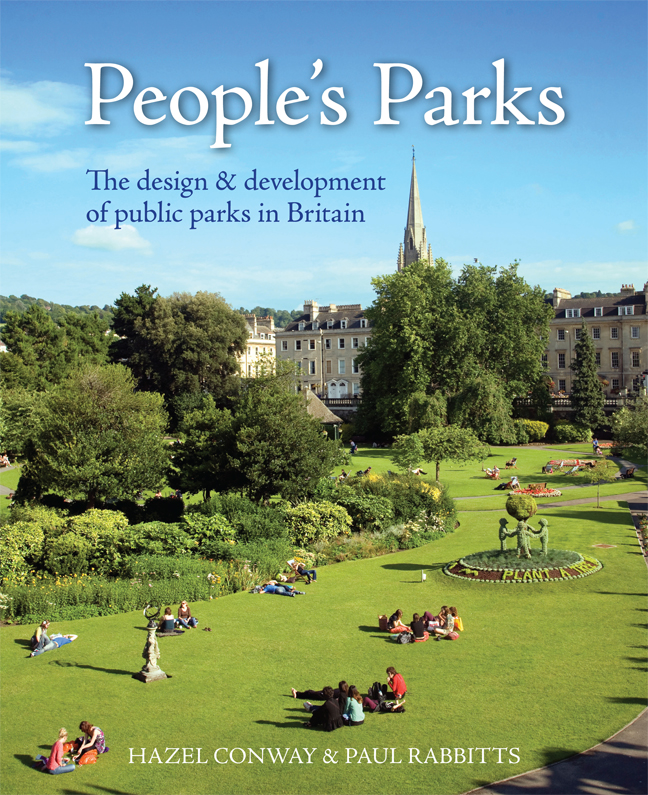Book contents
- Frontmatter
- Dedication
- Contents
- Miscellaneous Frontmatter
- Preface
- Acknowledgements
- Foreword
- A Word from Parks Professionals, Politicians and Parks Organisations
- Introduction: Dr Hazel Conway (1991)
- 1 Public Parks and Municipal Parks
- 2 The Need for Parks
- 3 Pioneering Parks Development
- 4 The Park Movement
- 5 Design and Designers
- 6 Lodges, Bandstands and the Cultivation of Virtue
- 7 Local Pride and Patriotism
- 8 Planting and Park Maintenance
- 9 Permitted Pastimes
- 10 Recreation Grounds, Parks and the Urban Environment
- 11 Public Parks, 1885–1914
- 12 Later Municipal Park Designers
- 13 Garden Cities and the New Towns Movement
- 14 Sport, Physical Activity and Recreation in Public Parks in the Inter-war Years
- 15 Parks Management – a Changing Perspective
- 16 Decline, Revival and Renewal – the Role of Parks into 21st-century Britain
- Appendix 1 Summary of main legislation promoting early park development
- Appendix 2 Chronology of main municipal and public park developments between 1800 and 1885
- Notes
- Bibliography
- Subscription List
- Index
5 - Design and Designers
Published online by Cambridge University Press: 22 February 2024
- Frontmatter
- Dedication
- Contents
- Miscellaneous Frontmatter
- Preface
- Acknowledgements
- Foreword
- A Word from Parks Professionals, Politicians and Parks Organisations
- Introduction: Dr Hazel Conway (1991)
- 1 Public Parks and Municipal Parks
- 2 The Need for Parks
- 3 Pioneering Parks Development
- 4 The Park Movement
- 5 Design and Designers
- 6 Lodges, Bandstands and the Cultivation of Virtue
- 7 Local Pride and Patriotism
- 8 Planting and Park Maintenance
- 9 Permitted Pastimes
- 10 Recreation Grounds, Parks and the Urban Environment
- 11 Public Parks, 1885–1914
- 12 Later Municipal Park Designers
- 13 Garden Cities and the New Towns Movement
- 14 Sport, Physical Activity and Recreation in Public Parks in the Inter-war Years
- 15 Parks Management – a Changing Perspective
- 16 Decline, Revival and Renewal – the Role of Parks into 21st-century Britain
- Appendix 1 Summary of main legislation promoting early park development
- Appendix 2 Chronology of main municipal and public park developments between 1800 and 1885
- Notes
- Bibliography
- Subscription List
- Index
Summary
In a sense, the design of each park was the solution to the particular factors affecting each individual project. Parks ranged in size from fractions of a hectare to several hundred hectares, and they were created out of a wide variety of sites which included commons, wasteland, infill and marginal land such as disused quarries. Some parks were created out of sites that were already partly laid out if they had previously been private parks and gardens, while others such as Moor Park, Preston, were not fully laid out until many years after they actually opened as parks. Despite this, it is possible to see certain broad changes in design during the course of the 19th century.
The most important influence on landscape design at the beginning of the 19th century was Humphry Repton. It was his theories that influenced John Nash in his revised designs for Regent's Park, and his ideas were kept alive well into the 19th century by John Claudius Loudon. It was Repton who first attempted to draw up the fundamental principles of landscape gardening and to analyse the sources of pleasure in it. Although the problems of public park design were very different from those involved in the design of private parks, many of his principles, particularly those concerning picturesque beauty, variety, novelty, contrast, appropriation and animation, were influential in the early phase of urban park design in the 1840s. Picturesque beauty encouraged curiosity, and this in turn meant that all the significant features of a design should not be immediately visible. Appropriation involved enhancing the apparent extent of an owner's private property, and this was applied to public parks, where it was important to give the appearance of as large an extent of park as possible. Other sources of pleasure identified by Repton included the changing seasons and animation that enlivened the scene by means of the movement of water or animals or smoke from distant dwellings, although smoke was hardly a positive factor for urban park designers and park keepers.
Apart from Repton and Loudon, the other major figure during the first decades of the park movement is undoubtedly Joseph Paxton. As previously referenced, Paxton's first public park was Prince's Park, Liverpool (1842), his first municipal venture Birkenhead Park (1842–47), but the Crystal Palace Park, Sydenham (1855), which was a speculative development, was his most influential park design.
- Type
- Chapter
- Information
- People's ParksThe design & development of public parks in Britain, pp. 43 - 80Publisher: Boydell & BrewerPrint publication year: 2023



